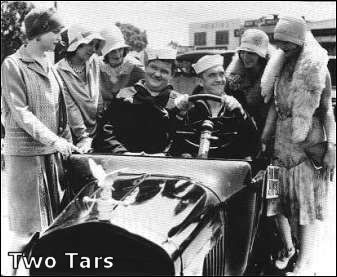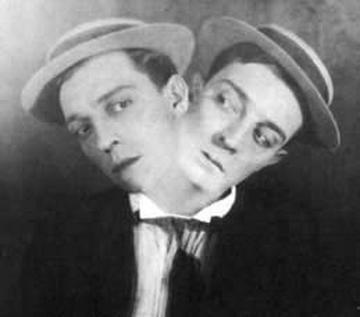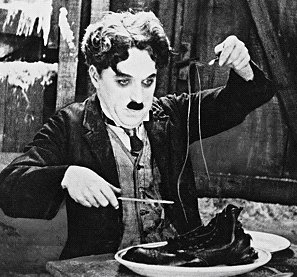Three
classic silent film comedies will be shown with live piano accompaniment
at the Wilton
Cannon Grange, Wilton, CT on Saturday February 17, 2007 at 7:30 pm. Children
and adults will enjoy a feature and two 12-minute comedies from the golden
age of silent cinema.
Charles Chaplin's "The
Gold Rush" (1925), one of the most celebrated silent films is the feature,
with Laurel and Hardy's "Two Tars" (1928), and Buster Keaton's "The Electric
House"
(1922).
Noted
silent film accompanist and film historian John Mucci of Wilton will
play a live score. Refreshments will be served at 7:00 pm, and the
films will begin at 7:30 pm, with intermissions between the reels. Admission
is free.
The Wilton Cannon
Grange Hall, at 25 Cannon Road has ample parking available at the Cannondale
Railroad Station. Click here for directions.
ABOUT THE FILMS:
THE GOLD RUSH (1925)
The feature film, Chaplin's "The
Gold Rush," is one of his most famous films, and certainly an iconic
film from the 1920's. Inspired by looking at stereopticons in Douglas
Fairbank's living room, of the Klondike's Chilkoot Pass, Chaplin worked
on this
film for
many years. It was not an easy film to make, considering he traveled
a crew to Truckee, California to re-enact scenes of gold-rush era miners
climbing the mountains in snow; but it was probably more difficult in
that he began shooting the film with the ingenue played by Lita Grey,
who not only became romantically involved with Chaplin, but under somewhat
mysterious circumstances, became his second wife. In any event, because
she was pregnant, Chaplin had to scrap what was shot with Lita and re-shoot
with Gloria Hale (who also became romantically involved with Chaplin,
but didn't marry him). The heroine's name in the final cut is "Georgia,"
by the way.
The plot concerns the adventures
of the "Little Tramp" character, who is fueld with Gold Fever, and stakes
his claim at a mine. Holed up during a blizzard with his partner, played
by Mack Swain, the pair counter starvation by trying to eat a) a shoe,
decked out like a chicken on a platter, and b) Chaplin, who in Swain's
delirium surreally takes on the form of a chicken and is chased around
the cabin.
Poignant, hilarious, slapstick and drama all rolled into one, The Gold Rush
has brought a smile and a tear to many since it first was shown in 1925.
TWO TARS (1928)
 Reminiscent
of last year's "Big Business," Laurel and Hardy's "Two Tars", made the
year before, has the boys on shore leave, and getting into a traffic
jam. Long-heralded as one of their true silent classics, "Two Tars" has
been called a primer on "How to Make a Silent Comedy." One
ingenious sight gag on top of another, with no regard for a story.
The film opens with a montage of patriotic images honoring our fighting men of
the sea, although there's really no need for Laurel and Hardy to be cast as sailors
-- save for the fact that comely young ladies seem to find Stan and Ollie instantly
attractive once they're dressed in their "Crackerjacks." Also
features James Finlayson, one
of the
Hal Roach Comedy All-stars, who appeared in 33 of
their films.
Reminiscent
of last year's "Big Business," Laurel and Hardy's "Two Tars", made the
year before, has the boys on shore leave, and getting into a traffic
jam. Long-heralded as one of their true silent classics, "Two Tars" has
been called a primer on "How to Make a Silent Comedy." One
ingenious sight gag on top of another, with no regard for a story.
The film opens with a montage of patriotic images honoring our fighting men of
the sea, although there's really no need for Laurel and Hardy to be cast as sailors
-- save for the fact that comely young ladies seem to find Stan and Ollie instantly
attractive once they're dressed in their "Crackerjacks." Also
features James Finlayson, one
of the
Hal Roach Comedy All-stars, who appeared in 33 of
their films.
THE ELECTRIC
HOUSE (1922)
 This early Keaton short has him become an electrician, thanks to the wrong
diploma being handed to him. When he is asked to make a rich man's house
(in real life, Keaton's house in Hollywood) "electric" there are sight-gags
galore as just about every common task in the house is taken over by a
precursor to 'automation.' This includes a charming little train set that
emerges from the kitchen to deliver dinner, stopping at the right spots
(sometimes) to deliver food.
This early Keaton short has him become an electrician, thanks to the wrong
diploma being handed to him. When he is asked to make a rich man's house
(in real life, Keaton's house in Hollywood) "electric" there are sight-gags
galore as just about every common task in the house is taken over by a
precursor to 'automation.' This includes a charming little train set that
emerges from the kitchen to deliver dinner, stopping at the right spots
(sometimes) to deliver food.
It also means a swimming
pool that immediately fills up with water, and drains in a few seconds.
Of course, things get
out of hand and the electricity in the house seems to take
on a mind
of its own, but it all
turns out well in the end. (I think.) It kind of depends on what you
think of as a happy ending.
A
tacit thank you to a number of web contributors
for content.
